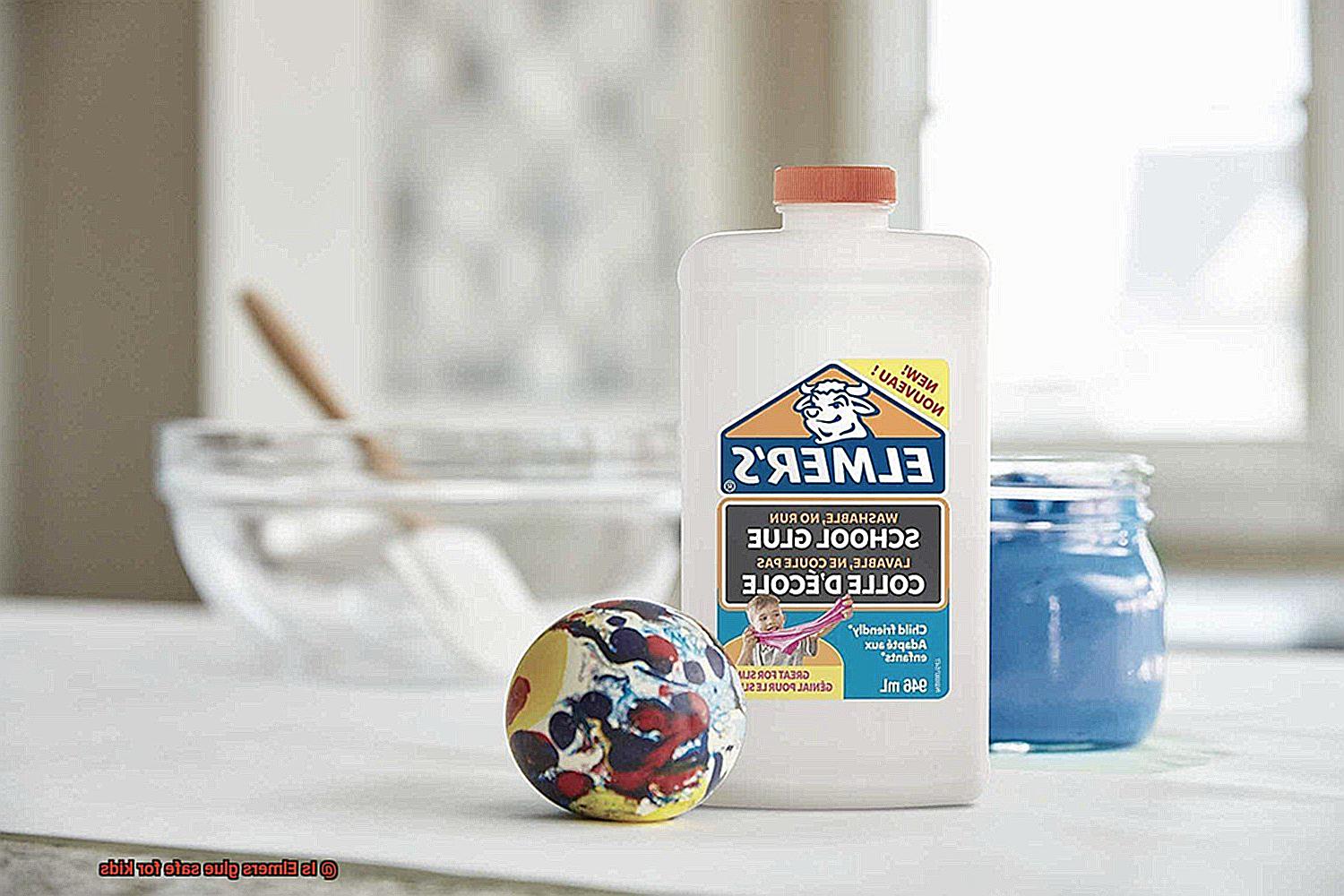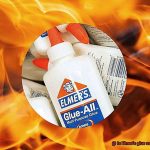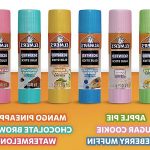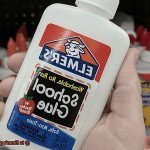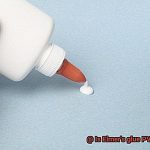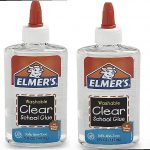Imagine a bunch of kids gathered around a craft table, their minds buzzing with ideas and excitement. They’re about to embark on a creative journey, armed with the trusty bottle of Elmer’s glue. But as parents and caregivers, we can’t help but wonder, “Is Elmer’s glue really safe for our little artists?”
Well, fret no more. In this guide, we’ll untangle the sticky situation surrounding the safety of Elmer’s glue for children. We’ll dig deep into its ingredients, explore any potential risks, and give you the lowdown on how to make sure your child’s artistic adventures are both fun and worry-free. So let’s dive in and discover the truth about this beloved crafting essential.
What is Elmer’s Glue?
Contents
In this blog post, we’ll explore why Elmer’s Glue has captured the hearts of crafters and delve into its various features and safety considerations.
The Magic of Elmer’s Glue:
Elmer’s Glue is a polyvinyl acetate (PVA) glue, a water-based polymer emulsion that can bond a wide range of materials together. From paper and cardboard to fabric and even wood, this versatile glue is your ticket to unlimited creativity.
Safe for Little Hands:
Parents and teachers love Elmer’s Glue because it’s non-toxic, making it safe for children to use. Accidental ingestion or contact with skin won’t cause harm. Just remember, while it’s safe in small quantities, avoid large consumption or if your child has allergies to any ingredients.
Easy Cleanup:
Accidents happen, especially when little ones are involved. But fear not. Elmer’s Glue is washable, allowing for quick and easy cleanup with just water. No more sticky messes to worry about – now you can focus on creating without the hassle.
Specialty Formulations:
Elmer’s Glue understands that one size doesn’t fit all in the world of crafting. That’s why they offer specialty formulations like glitter glue for that extra touch of sparkle or rubber cement and wood glue for stronger adhesion in specific applications. Whatever your project demands, Elmer’s has you covered.
Safety First:
Elmer’s Glue prioritizes safety above all else. It has undergone rigorous testing to meet industry standards set by organizations like ASTM. You can trust that Elmer’s Glue is free from harmful substances, giving you peace of mind as you create.
Is Elmer’s Glue Safe for Kids?
Concerned about Elmer’s Glue’s safety for your little ones? Look no further. Let’s dive into the world of Elmer’s Glue, exploring its safety features and providing you with all the information you need for worry-free creativity.
Non-Toxic Formulation:
Elmer’s Glue is specifically formulated with children in mind. It consists of water, polyvinyl acetate (PVA), and other safe ingredients commonly found in school glues. Rest assured, it meets and exceeds safety standards set by regulatory agencies like the CPSC and ASTM.
Extensive Safety Testing:
PVA, a synthetic polymer and key component in Elmer’s Glue, has undergone thorough testing to ensure its safety. Widely used in consumer products like adhesives and paints, it’s a trusted ingredient that won’t let you down.
Adult Supervision and Instructions:
Elmer’s Glue is generally safe but should be used under adult supervision. Ensure your child follows the packaging instructions, like avoiding ingestion and prolonged skin contact.
Ingestion Risks:
Accidental ingestion of small amounts of Elmer’s Glue won’t cause harm. However, large quantities may lead to gastrointestinal discomfort such as nausea or vomiting. Seek medical attention for adverse symptoms.
Skin Sensitivity:
Prolonged skin contact may cause mild irritation or allergic reactions in some individuals. If any skin irritation occurs, wash it off with soap and water.
Safer Alternatives:
For added peace of mind, consider non-toxic glue sticks or washable markers, especially for younger children who tend to put things in their mouths.
Non-Toxic and Safe Ingredients
When it comes to finding safe and non-toxic art supplies for your children, Elmer’s Glue is the perfect choice. This beloved crafting staple not only offers endless fun and versatility but also boasts a range of ingredients that are completely safe for your little ones.
Let’s dive into the primary ingredient in Elmer’s Glue: polyvinyl acetate (PVA). This synthetic polymer is the secret behind the glue’s impressive adhesive properties. The great news is that PVA is considered non-toxic and poses no significant health risks when used as directed. So, even if your child accidentally decides to taste a bit of Elmer’s Glue (we’ve all been there.), you can rest easy knowing that it won’t cause any harm.
But that’s not all. Elmer’s Glue also contains good old water, which acts as a solvent to make the glue easier to spread and apply. Fortunately, water is something we encounter every day and is perfectly safe for consumption. So, even if your budding artist decides to take a sip (again, it happens), there’s no need to panic.
Now, you might be wondering if there are any other ingredients in Elmer’s Glue that could raise concerns. Fear not. Any additives or preservatives used in the glue are carefully selected and regulated to ensure they meet safety standards. Elmer’s Glue is specifically formulated with children in mind, so extra precautions are taken to guarantee its safety.
To maximize your child’s safety when using Elmer’s Glue, it’s crucial to follow the instructions provided on the packaging. This includes using the glue in well-ventilated areas and avoiding contact with eyes or prolonged skin exposure. And of course, it’s always wise to supervise young children when they’re using any type of adhesive – after all, creativity should be both fun and worry-free.
Rest assured that Elmer’s Glue has undergone rigorous testing and meets safety standards set by regulatory authorities, such as the Consumer Product Safety Commission (CPSC). These organizations ensure that products intended for children are safe and free from hazardous substances.
Potential Allergies or Sensitivities
For generations, Elmer’s Glue has been a trusted companion in children’s crafting activities. Its non-toxic and washable formula has made it a go-to choice for parents and educators alike. However, it is crucial to be aware that some children may have allergies or sensitivities to certain ingredients in this popular glue. In this blog post, we will delve deeper into this topic, exploring potential allergens and offering tips to ensure a safe crafting experience.
Latex Allergy:
Elmer’s glue contains latex, a common allergen. While latex allergies are relatively rare, they can cause mild to severe reactions in sensitive individuals. Symptoms may include skin redness, itching, hives, swelling, or even difficulty breathing. If your child has a known latex allergy, it is crucial to avoid any products containing latex, including Elmer’s glue.
Preservatives:
Elmer’s glue also contains preservatives like methylisothiazolinone (MIT) or benzisothiazolinone (BIT). These ingredients are necessary to maintain the glue’s shelf life but can potentially cause skin irritation or allergic reactions in some people. To prevent such reactions, it is recommended to perform a patch test on a small area of the skin before using Elmer’s glue on larger areas.
Patch Test:
Performing a patch test is simple yet essential. Apply a small amount of the glue on your child’s forearm or behind their ear and wait for 24 hours. If there is no redness, itching, or any other signs of an allergic reaction, it is likely safe to proceed with using Elmer’s glue.
Recognizing Allergic Reactions:
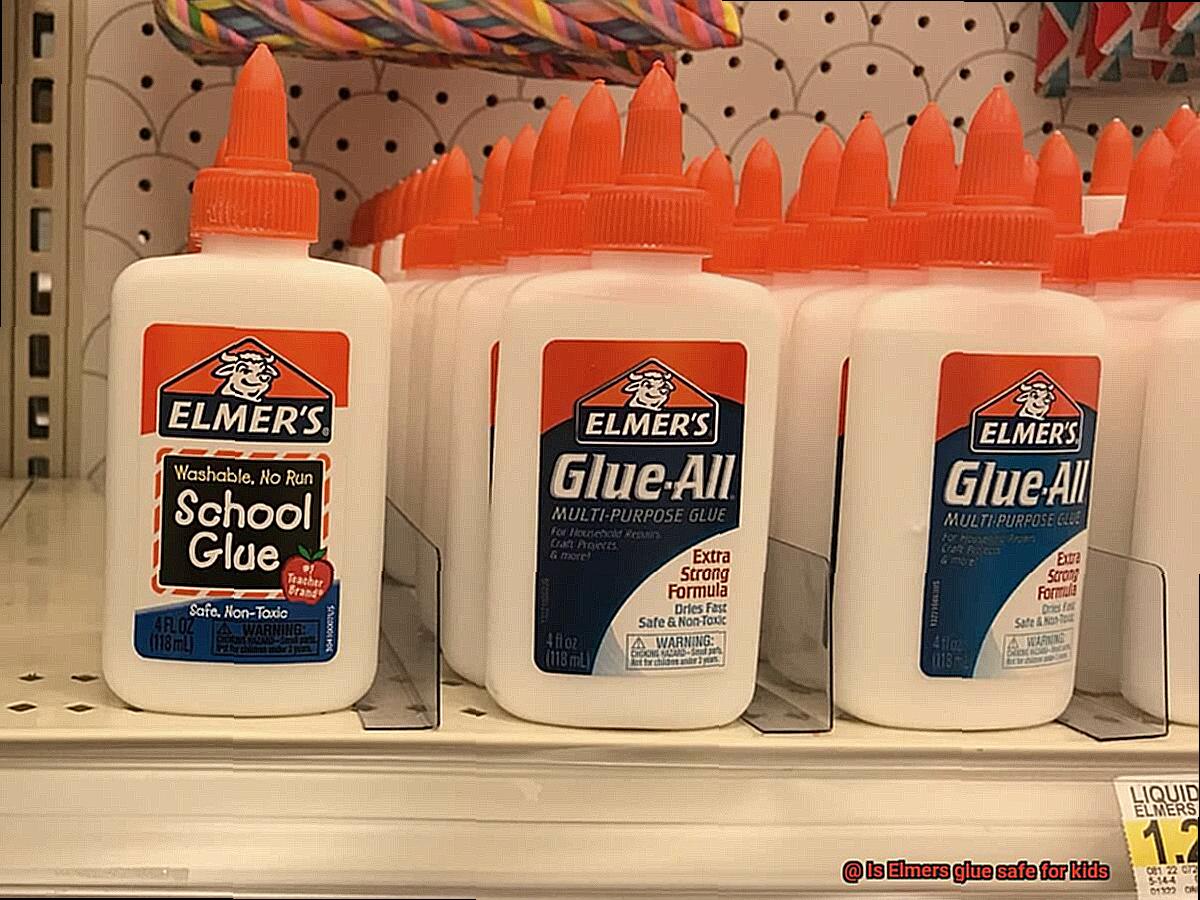
If your child develops any signs of an allergic reaction after using Elmer’s glue, such as redness, swelling, itching, or a rash, it is best to discontinue its use immediately. Consult a healthcare professional for further guidance and to determine the best course of action.
Safety Features of Elmer’s Glue
Elmer’s glue is not only a popular choice for arts and crafts projects but also a safe one for kids. Let’s take a closer look at its safety features to put your mind at ease.
First and foremost, Elmer’s glue is non-toxic. This means that it does not contain any harmful substances that could pose a risk to children. Even if your little one accidentally ingests small amounts of the glue, there is no need to panic. However, it is important to note that while Elmer’s glue is non-toxic, it is not intended for consumption, so it’s best to discourage children from tasting or eating it.
Another great safety feature of Elmer’s glue is its washability. Being water-based, this glue can be easily washed off from skin and most fabrics with soap and water. This not only makes cleanup after craft time a breeze but also reduces the chances of any skin irritation or allergic reactions caused by prolonged exposure to the glue.
In addition to being non-toxic and washable, Elmer’s glue has a low odor. Unlike some other glues on the market that emit strong fumes, Elmer’s glue has a minimal odor, making it more pleasant to work with and reducing the risk of any adverse reactions.
But wait, there’s more. Elmer’s glue meets stringent safety standards set by regulatory bodies such as the American Society for Testing and Materials (ASTM). This means that the glue undergoes rigorous testing to ensure it meets specific criteria for safety, performance, and quality. By conforming to these standards, Elmer’s glue provides an added assurance of its safety for children.
Furthermore, Elmer’s has gone the extra mile to enhance the safety of their glue products by offering options like glue sticks and washable glue pens. Glue sticks are a solid form of glue that eliminates the risk of spills and mess, making them particularly suitable for young children. Washable glue pens, on the other hand, offer precision and control while being easy to wash off, providing a safer alternative for intricate craft projects.
Supervising Children When Using Elmer’s Glue
As parents, we always want the best for our children. We strive to create a safe environment for them to learn and explore, especially when it comes to their creative endeavors. While Elmer’s glue is generally considered safe for children to use, it is crucial that we supervise them during their crafting sessions. Here’s why:
- Accidental ingestion or misuse: Young children have a knack for putting things in their mouths. Even though Elmer’s glue is non-toxic, it is essential to keep an eye on them to prevent accidental ingestion or misuse of the product.
- Responsible glue usage: By supervising our little ones, we can teach them how to use glue responsibly. This includes using the recommended amount and avoiding putting glue on their skin or clothing. These lessons will not only protect their health but also promote good habits in handling potentially harmful substances.
- Age-appropriate glue selection: Always ensure that your child is using age-appropriate glue, such as Elmer’s School Glue. This specific type of glue is non-toxic and washable, providing added safety and peace of mind.
- Clear instructions and demonstrations: When supervising children, provide clear instructions on how to use the glue and demonstrate the proper technique. This will help them understand the importance of using glue safely and effectively.
- Well-ventilated areas: Encourage children to use glue in well-ventilated areas to avoid inhaling fumes. This simple precaution can prevent any potential respiratory issues.
- Cleaning up accidents: Accidents happen, and if your child accidentally gets glue on their skin, it can be easily washed off with soap and water. Promptly attending to any mishaps ensures a quick resolution and prevents any discomfort.
- Accidental ingestion: In case of accidental ingestion, seek medical attention immediately and provide the healthcare professional with information about the product. While Elmer’s glue is non-toxic, it is always better to be safe than sorry.
- Safe storage: Lastly, store glue out of reach of young children when not in use. This prevents accidental ingestion or misuse and ensures that our little ones can only access it under adult supervision.
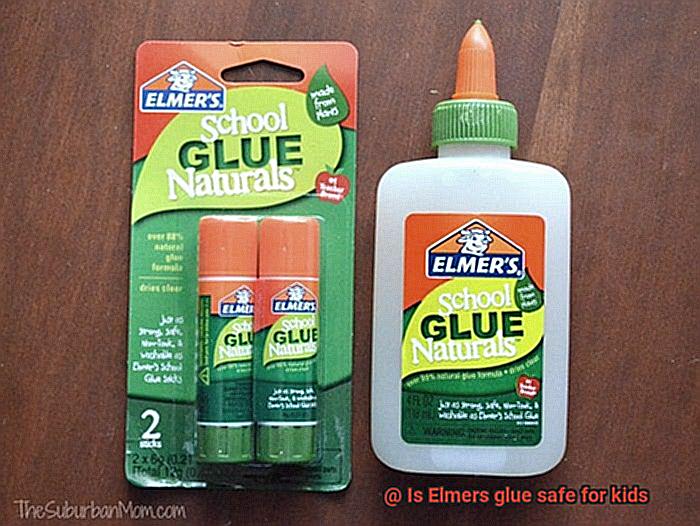
Storing Elmer’s Glue Safely
Elmer’s glue is a beloved adhesive in households with creative kids. From school projects to arts and crafts at home, this versatile glue is a must-have. But how can you ensure the safe storage of Elmer’s glue? In this comprehensive guide, we will walk you through essential steps to safeguard your little artists.
Choose the Perfect Storage Spot:
- Opt for a cool, dry location away from direct sunlight to prevent drying out or deterioration.
- Consider placing it in a high cabinet or shelf, beyond the reach of curious young children, ensuring their safety.
Lock It Tight:
Swift Spill Cleanup:
- Accidents happen, but fear not. Elmer’s glue is water-soluble, making cleanup a breeze with warm, soapy water.
- For added protection, wear gloves while cleaning up any spills.
Vigilantly Inspect:
- Regularly examine the glue’s consistency and smell. Any unusual changes indicate the need for replacement.
- Using expired or old glue can compromise its performance and safety.
Heed Instructions:
Keep It Separate from Food:
Also Read: Is Elmer’s Glue Toxic?
Conclusion
In conclusion, Elmer’s glue is the perfect companion for children’s crafting activities. Its formulation is not only non-toxic but has also undergone extensive safety testing to ensure its reliability. With Elmer’s glue, parents and educators can rest easy knowing that industry standards are met and exceeded.
At the heart of Elmer’s glue is polyvinyl acetate (PVA), a harmless ingredient that poses no significant health risks when used as directed. Plus, it contains water – a substance we consume every day without worry. And any additives or preservatives used in the glue are carefully chosen and regulated to meet stringent safety standards.
Of course, it’s important to be mindful of potential allergies or sensitivities some children may have to certain ingredients in Elmer’s glue. For instance, latex allergies or reactions to preservatives like methylisothiazolinone (MIT) or benzisothiazolinone (BIT) can occur in sensitive individuals. To identify any potential allergic reactions, performing a patch test on a small area of skin before use is recommended.
To make sure your child’s crafting experience with Elmer’s glue is as safe as can be, there are some simple precautions you can take. Start by supervising their creative endeavors, encouraging responsible glue usage, and providing clear instructions and demonstrations. And always choose well-ventilated areas for crafting sessions while promptly cleaning up any accidents that may occur.
When it comes to storage, remember to select the right spot for your Elmer’s glue and seal the lid tightly when not in use. In case spills happen, clean them up with warm soapy water immediately. Regularly inspect the consistency and smell of the glue, following instructions provided on the packaging diligently. And most importantly, keep it separate from food items.

